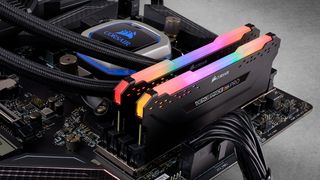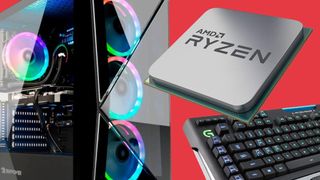AMD Ryzen 5000 isn't hitting its full memory potential at launch
If you've been eyeing up 4000MHz DDR4, you probably want to wait for the BIOS updates.

AMD has confirmed that hitting 2,000MHz on the Infinity Fabric clock of Ryzen 5000 CPUs may not be as easy as first hoped. In fact you may not have any luck at all, which would mimic our own experience of trying to get a set of Corsair Vengeance RGB Pro DDR4-4000MHz RAM running for our Ryzen 9 5900X review. To be clear the memory worked just fine, but any attempts at running the FCLK above 1,800MHz resulted in misery.
I reached out to AMD to see what was happening, and this was the response:
"We are working on additional optimizations for 1900-2000MHz fabric clocks in our next AGESA release. AMD cannot guarantee any samples, including your own, will be able to hit these speeds. Although some current Ryzen 5000 samples are able to achieve a 1900+ fabric speed we feel confident even more users will be able to obtain these speeds with the forthcoming optimizations. If you recall on the 3000 series many, but not all, users were able to achieve a fabric speed of 1900. We believe this will be a similar situation with 5000 series processors and 2000MHz."
The reason this is important is because you want a 1:1 ratio for your memory clock and the Infinity Fabric for optimal performance. Running your memory at 4,000Mhz (which is actually on a 2,000MHz clock) alongside a FCLK of 1,800MHz means that the buses are not lining up quite as neatly as they could be.
In theory it should be a simple case of setting the memory profile in your BIOS and the FCLK is changed automatically. As this wasn't happening, I tried setting the FCLK manually, but this just resulted in the motherboard boot cycling—attempting to power up, but then falling over and resetting itself continually. I'm sure a BIOS update will sort this out at some point, but right now it means we don't get to see how much an improvement you can get from higher clocked memory running at the same speed as the Infinity Fabric.

Black Friday 2020 deals: the place to go for the all the best Black Friday bargains.
This isn't the first time that we've seen a potential increase in the FCLK, as the XT chips that were released this summer could potentially run at 1,900MHz. Some users managed to get the Infinity Fabric running at 1,900MHz and the memory at 3,800MHz, although the actual difference this made to games wasn't always so clear. More importantly not every combination of processor, motherboard and memory proved successful, which is probably why AMD didn't shout about this upgrade too much.
We had hoped Zen 3 was going to be more forthright about this, but it would seem not at launch.
The biggest gaming news, reviews and hardware deals
Keep up to date with the most important stories and the best deals, as picked by the PC Gamer team.
There is another thing to be aware of here as well, and it's that 4,000MHz DDR kits are considered something of a premium, and are expensive. And while there will be some that will be clamouring to pick up their memory overclocking soapboxes, the vast majority of system builders want to reach for a RAM kit that they can plug in and clock one button to get up and running. And they don't want to pay a fortune for the privilege, especially if the memory isn't running as optimally as it can do.
Watch this space, basically.
Alan has been writing about PC tech since before 3D graphics cards existed, and still vividly recalls having to fight with MS-DOS just to get games to load. He fondly remembers the killer combo of a Matrox Millenium and 3dfx Voodoo, and seeing Lara Croft in 3D for the first time. He's very glad hardware has advanced as much as it has though, and is particularly happy when putting the latest M.2 NVMe SSDs, AMD processors, and laptops through their paces. He has a long-lasting Magic: The Gathering obsession but limits this to MTG Arena these days.
Most Popular







